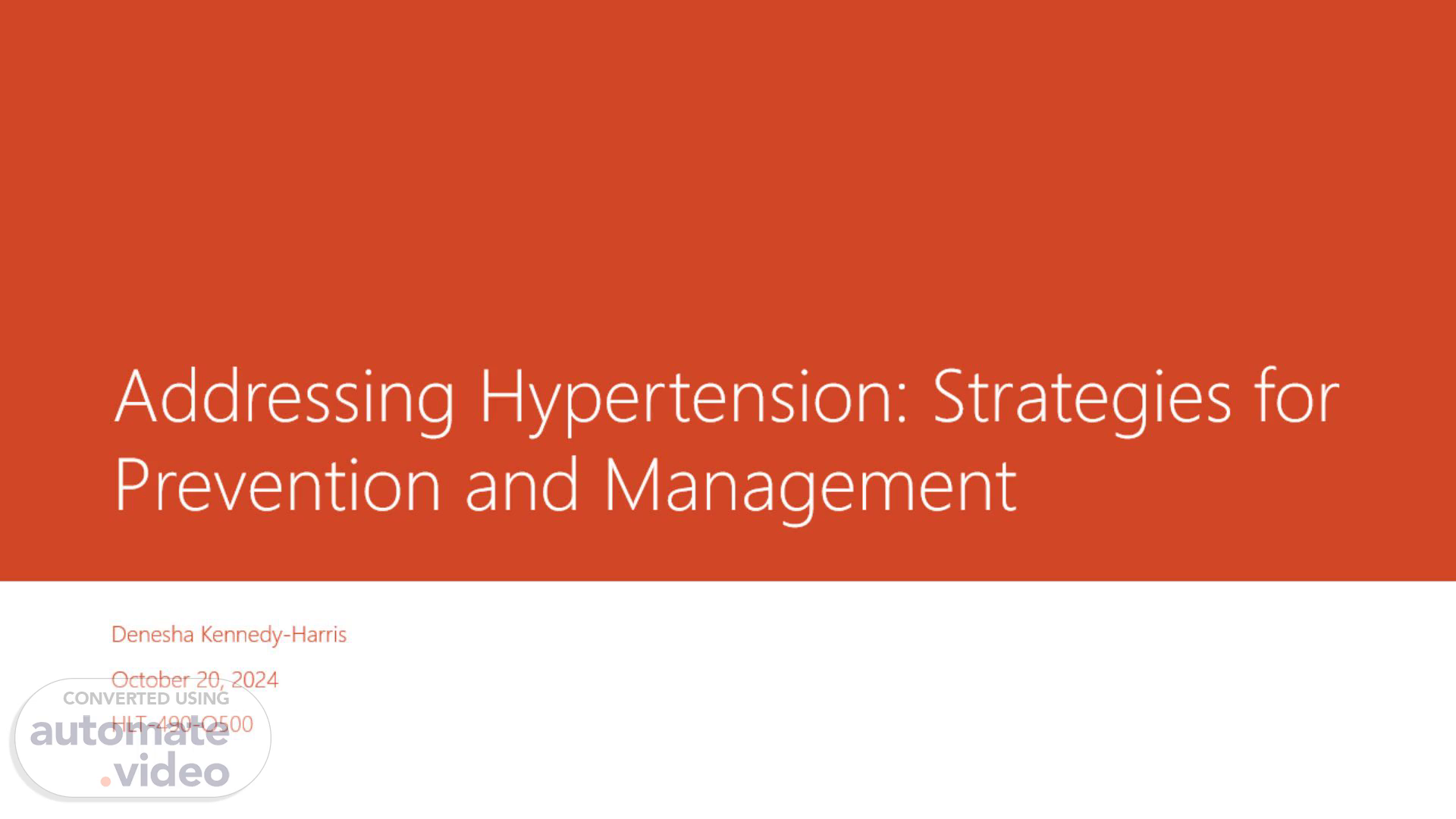
Addressing Hypertension: Strategies for Prevention and Management
Scene 1 (0s)
[Audio] Addressing Hypertension: Strategies for Prevention and Management.
Scene 2 (9s)
[Audio] Introduction Brief description of the E-B-P proposal: This proposal aims to address hypertension, a prevalent health issue characterized by consistently high blood pressure levels, through evidence-based strategies for prevention and management. Importance of the topic: Hypertension affects nearly one in three adults and increases the risk of heart disease, stroke, and kidney failure. Addressing this issue can significantly improve public health outcomes..
Scene 3 (38s)
[Audio] Problem Statement Define the healthcare problem addressed: Hypertension is often referred to as a "silent killer" because it usually has no symptoms but can lead to serious health complications. Why it is significant: The global burden of hypertension continues to rise, leading to increased healthcare costs and decreased quality of life for those affected..
Scene 4 (1m 2s)
[Audio] Review of Literature Summary of literature reviewed: Recent studies show that lifestyle interventions, such as diet and exercise, can effectively lower blood pressure. Key findings relevant to the proposal: A low-sodium diet and routine physical activity have been shown to significantly reduce hypertension in diverse populations (Oparil and others, 2018; Whelton and others, 2018)..
Scene 5 (1m 30s)
[Audio] Theoretical Framework Overview of the theoretical framework guiding the proposal: The Health Belief Model (H-B-M--) will guide the proposal, focusing on individuals' beliefs about health behaviors. Why this framework is applicable: The H-B-M helps understand how personal beliefs influence individuals' actions regarding their hypertension management..
Scene 6 (1m 53s)
[Audio] Mehtodology Discuss the research design: A quasi-experimental design will be used to asses the impact of educational interventions on hypertension management. Population and sample size: The target population will be adults aged 30-65, with a sample size of 100 participants recruited from primary care clinics. Data collection methods: Surveys and blood pressure readings will be collected pre and post-intervention..
Scene 7 (2m 22s)
[Audio] Data Analysis Plan Explain how data will be processed and analyzed: Data will be analyzed using S-P-S-S software to compare pre-and post-intervention blood pressure levels. Tools and software to be used: S-P-S-S (Statistical Package for the Social Sciences) will be used for statistical analysis..
Scene 8 (2m 44s)
[Audio] Expected Outcome Describe the anticipated results of the research: The proposal expects to demonstrate a significant reduction in blood pressure levels among participants who undergo the educational intervention. How these outcomes will impact patient care: Improved blood pressure control can reduce the risk of cardiovascular diseases, leading to better health outcomes..
Scene 9 (3m 7s)
[Audio] Dissemination of Findings Summarize plans for disseminating evidence: Findings will be shared through professional journals, community health fairs, and presentations to healthcare providers. Identify professional organizations, conferences, and journals: Target journals include the American Journal of Hypertension and conferences such as the American Heart Association's Scientific Sessions..
Scene 10 (3m 34s)
[Audio] Importance of Ongoing Research Discuss the value of continued evidence-based research: Ongoing research is vital for developing new methods to manage hypertension effectively. Explain how it deepens knowledge and expands skills: Participating in research will keep healthcare providers a breast of new findings and innovative treatments. Personal Strategies for incorporating new findings into practice: Attend workshop, subscribe to health journals, and engage in peer discussions..
Scene 11 (4m 11s)
[Audio] Implementation Plan Overview of how findings can be implemented in practice: Training sessions for healthcare providers to understand hypertension management will be organized. Stakeholder engagement strategies: Collaborate with local clinics and health agencies to implement findings effectively..
Scene 12 (4m 31s)
[Audio] Evaluation Plan Discuss how the effectiveness of the intervention will be measured: Effectiveness will be evaluated through follow-up surveys and regular blood pressure monitoring. Metrics for success and feedback loops: Success will be based on the percentage of participants achieving target blood pressure levels and feedback will be gathered from participants to improve future interventions..
Scene 13 (5m 6s)
[Audio] Conclusion Recap the significance of the proposal: This proposal highlights the urgent need to address hypertension through evidence-based strategies. Call to action for continued research: Encourage healthcare professionals to engage in ongoing education and research to improve hypertension management..
Scene 14 (5m 27s)
[Audio] References Oparil, S., and others (2018). Hypertension. The Lancet, 391(10116), 2055-2-0-6-7 Whelton, P K , and others (2018). 2017 Guideline for High Blood Pressure in Adults. Hypertension, 71(6), e13-e115..
Scene 15 (5m 58s)
[Audio] Questions Thank you for your attention and welcome any inquiries or discussions related to hypertension management..